Identifying ripe fruit. 1st part: Tropical fruit
Tuesday 19 th April 2016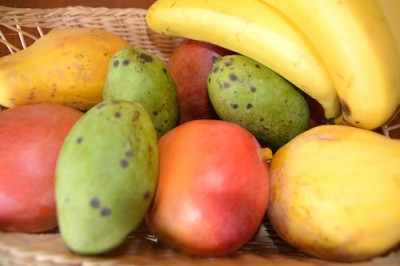 It’s very important to eat fruits that are ripe. But unfortunately most of fruits are picked when they have not reached maturity yet and they are sold unripe, specially in the countries that are not the producers, because fruits must resist the transport without being spoiled.
It’s very important to eat fruits that are ripe. But unfortunately most of fruits are picked when they have not reached maturity yet and they are sold unripe, specially in the countries that are not the producers, because fruits must resist the transport without being spoiled.In this case, it would be better to finish the ripening process at home, although the fruit will never have the same sweet taste and intense perfume than a tree-ripened fruit.
So, how can we identify when a fruit is ripe?
In this article we will show you some photos and we give some explanations that could help you identifying when a fruit is perfectly ripe.
When tropical fruits arrive to the destined country, the distributors use different techniques to quickly ripen and sell fruit with a more attractive aspect. In other cases, fruits are ripened during the trip.
One of the most used methods for a quick ripening is the use of cameras of ethylene gas. The ethylene gas is naturally produced by several fruits, such as bananas, peaches and tomatoes, and help the maturation. In the cameras, an artificial ethylene gas is employed. The process of forced maturation with ethylene gas results to inferior quality fruits, that have the same colour as ripe fruit, but the texture is hard and has no taste nor smell.
Usually small greengroceries give precious advices about how many days a fruit that is bought needs to ripen. It’s worth to buy in these shops and to let them give us advice.
Also, look for shops that sell fruits that haven’t been ripened by camera and let them ripen naturally in the kitchen. Although the ideal is a tree-ripened fruit, it’s better to have a slow maturation than a fast one with artificial gas.
In order to ripen fruits at home, keep fruits at room temperature in the kitchen in wicker trays during the day, and keep fruits inside paper bags during the night to protect them from insects.
To aid the maturation of the unripe fruits, you can add ripe bananas or apples in the bag. The natural gas that release is going to boost the maturation of the other fruits.
In general, fruits release a very fragrant odeur when they are ripened, and acquire the colour of the fruit, without any green part. When fruits are too ripe, they begin to show brown bruises, a part from bananas and some types of mangos, that show light brown speckles when they are ripe.
Also, when they are too ripe and spoiled, the smell becomes alcoholic and they can begin to show some fungi.
When fruit is ripe it can be kept in the fridge to prevent that it spoils too fast. The skin of the banana turns brown in the fridge, but the flesh is still good.
Bananas are available all year long.
Ripe bananas are yellow with small brown speckles. If the banana have dark streaks and blotches it means that it has been through the camera procedure.
Unripe bananas have a undigestible starch. After maturation, this starch is converted into digestible sugar.
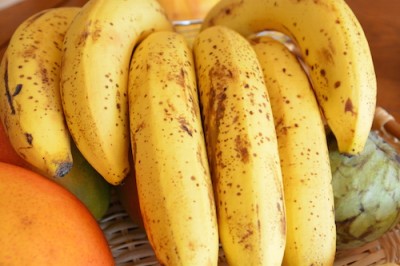
Ripe banana
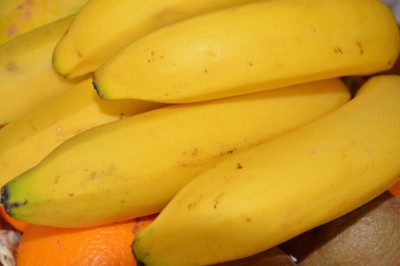
Unripe banana
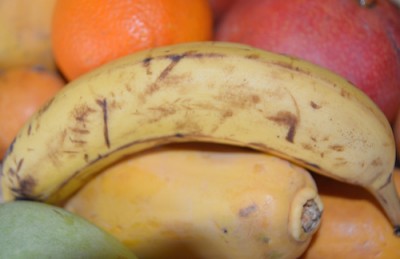
Banana ripened in camera
Pineapples grow in summer in South America and Africa, so the best season in Europe is winter and autumn.
Ripe pineapples have a golden or yellowy-orange colour, and release a fragrant odeur.
They begin the process of maturation from the bottom to the top. When the yellow colour covers at least 20% of the fruit, they begin to be ready to eat. Also, we can recognise when they are ripe because the leaves will come off easily when you tug at them.
When they are too ripe the smell becomes alcoholic and they are very soft at the bottom.
If a pineapple has been collected before it’s ripe, it will not be able to ripen afterwards. It will become soft and tasteless.
In this youtube you can find more information about how to identify a ripe pineapple and how to cut it.
In this photo you can compare a unripe pineapple (in the left) and a ripe pineapple (in the right)
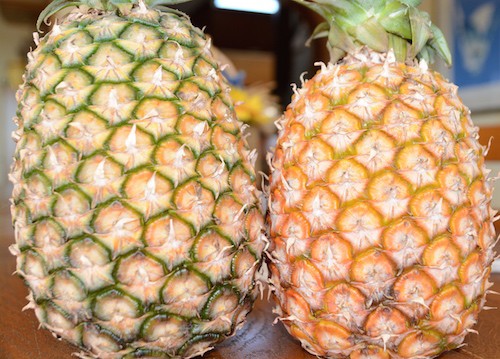
The season of papayas is summer and autumn in South America and Africa, so they are available in Europe all the winter and spring.
The flesh of the papaya has an orange colour when it’s ripe, the skin is yellow and it’s slightly soft to the touch. The taste will be sweet if it has ripened properly, but if it has been collected unripe then it will be tasteless although it is yellow and tender.
If it’s bought when it’s still a little bit unripe (the skin is partially green and the rest is yellow), then it can be left to ripen at home for a few days.
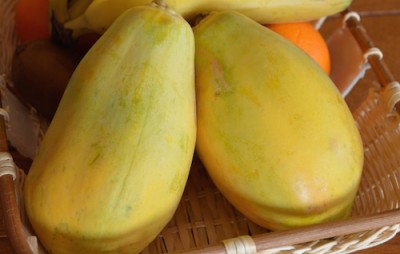
Unripe papaya
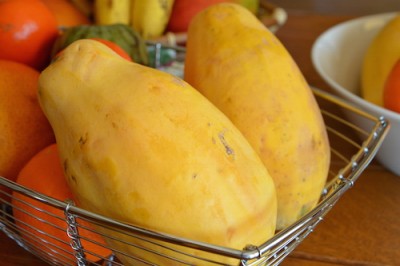
Ripe papaya
The season of the mango is spring, but some types are picked in summer, autumn and even in winter.
You can use the touch to know if a mango is ripe: it’s slightly soft. Do not rely on the colour of the mango, because every type of mango have a different colour: orange, yellow and also green.
A way to know if the wild mango with green skin is ripe is when it shows brown speckles.
Another way is the smell, that must be sweet and remind you of the taste of a ripe mango.
In this site you can find a good guide.
Mangos can ripen at room temperature.
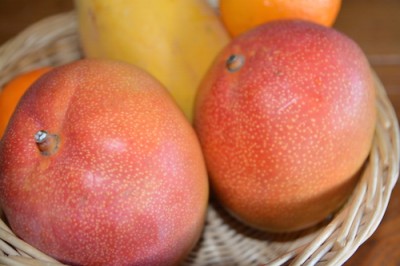
Ripe mango
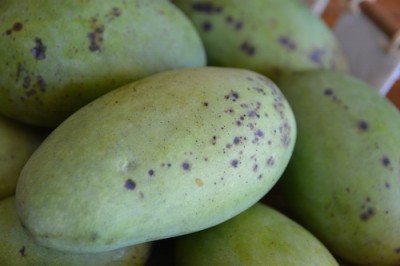
Ripe wild mango
The season of the cherimoya is autumn in South Europe (Spain and Mediterranean countries).
The skin is dark green with some brown areas when ripe and it’s slightly soft to the touch.
Cherimoyas continue to ripen after they have been harvested.
In this photo you can compare a ripe cherimoya (in the left) and a unripe cherimoya (in the right)
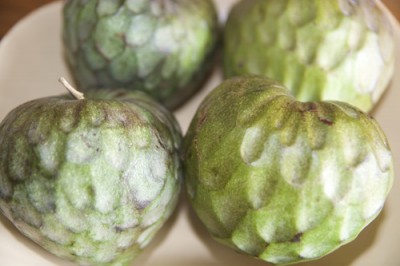
Thank you to my daughter Núria for the English corrections.
One of the most used methods for a quick ripening is the use of cameras of ethylene gas. The ethylene gas is naturally produced by several fruits, such as bananas, peaches and tomatoes, and help the maturation. In the cameras, an artificial ethylene gas is employed. The process of forced maturation with ethylene gas results to inferior quality fruits, that have the same colour as ripe fruit, but the texture is hard and has no taste nor smell.
Usually small greengroceries give precious advices about how many days a fruit that is bought needs to ripen. It’s worth to buy in these shops and to let them give us advice.
Also, look for shops that sell fruits that haven’t been ripened by camera and let them ripen naturally in the kitchen. Although the ideal is a tree-ripened fruit, it’s better to have a slow maturation than a fast one with artificial gas.
In order to ripen fruits at home, keep fruits at room temperature in the kitchen in wicker trays during the day, and keep fruits inside paper bags during the night to protect them from insects.
To aid the maturation of the unripe fruits, you can add ripe bananas or apples in the bag. The natural gas that release is going to boost the maturation of the other fruits.
In general, fruits release a very fragrant odeur when they are ripened, and acquire the colour of the fruit, without any green part. When fruits are too ripe, they begin to show brown bruises, a part from bananas and some types of mangos, that show light brown speckles when they are ripe.
Also, when they are too ripe and spoiled, the smell becomes alcoholic and they can begin to show some fungi.
When fruit is ripe it can be kept in the fridge to prevent that it spoils too fast. The skin of the banana turns brown in the fridge, but the flesh is still good.
Bananas
Bananas are available all year long.
Ripe bananas are yellow with small brown speckles. If the banana have dark streaks and blotches it means that it has been through the camera procedure.
Unripe bananas have a undigestible starch. After maturation, this starch is converted into digestible sugar.

Ripe banana

Unripe banana

Banana ripened in camera
Pineapple
Pineapples grow in summer in South America and Africa, so the best season in Europe is winter and autumn.
Ripe pineapples have a golden or yellowy-orange colour, and release a fragrant odeur.
They begin the process of maturation from the bottom to the top. When the yellow colour covers at least 20% of the fruit, they begin to be ready to eat. Also, we can recognise when they are ripe because the leaves will come off easily when you tug at them.
When they are too ripe the smell becomes alcoholic and they are very soft at the bottom.
If a pineapple has been collected before it’s ripe, it will not be able to ripen afterwards. It will become soft and tasteless.
In this youtube you can find more information about how to identify a ripe pineapple and how to cut it.
In this photo you can compare a unripe pineapple (in the left) and a ripe pineapple (in the right)

Papaya
The season of papayas is summer and autumn in South America and Africa, so they are available in Europe all the winter and spring.
The flesh of the papaya has an orange colour when it’s ripe, the skin is yellow and it’s slightly soft to the touch. The taste will be sweet if it has ripened properly, but if it has been collected unripe then it will be tasteless although it is yellow and tender.
If it’s bought when it’s still a little bit unripe (the skin is partially green and the rest is yellow), then it can be left to ripen at home for a few days.

Unripe papaya

Ripe papaya
Mango
The season of the mango is spring, but some types are picked in summer, autumn and even in winter.
You can use the touch to know if a mango is ripe: it’s slightly soft. Do not rely on the colour of the mango, because every type of mango have a different colour: orange, yellow and also green.
A way to know if the wild mango with green skin is ripe is when it shows brown speckles.
Another way is the smell, that must be sweet and remind you of the taste of a ripe mango.
In this site you can find a good guide.
Mangos can ripen at room temperature.

Ripe mango

Ripe wild mango
Chirimoya
The season of the cherimoya is autumn in South Europe (Spain and Mediterranean countries).
The skin is dark green with some brown areas when ripe and it’s slightly soft to the touch.
Cherimoyas continue to ripen after they have been harvested.
In this photo you can compare a ripe cherimoya (in the left) and a unripe cherimoya (in the right)

Thank you to my daughter Núria for the English corrections.
- Share
-

-

-

-

-

-
 Send to a friend
Send to a friend
-
 more...
more...
- | Post a Comment

